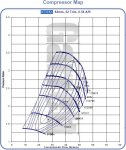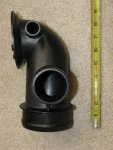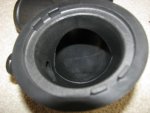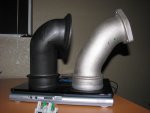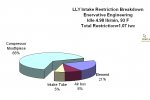These are all great responses. Love the enthusiasm. Johnboy, those are interesting points, and great insight. I have also wondered why someone hasn't come up with a wastegated VGT. In search of explanations for the severe amount of apparent parasitic drag, I too would typically focus on exhaust restriction. Yet, something just kept telling me that the intake side of the turbo had something wrong with it. Afterall, high drive pressure just means the turbine is resistant, since it is shaft connected to the compressor, it is entirely possible that there is nothing on the exhaust side causing the problem. The dramatic COT's I have logged (as high as 590 F) on the compressor side were trying to tell me something, and I started to believe that they were related to a hidden induction flaw.
Going back a bit, it took me nearly 2 years to resolve that LLY overheating frequency (compared to the LB7) had nothing to do with its cooling system. Some are familiar with this effort. It was not an easy paradigm shift to get away from looking at things like radiator design, water pump cavitation etc, and start looking at other relationships.
Anyway, this is a problem that involves looking at the compressor map. One objective of effective forced induction is to keep compressor efficiency as high as possible, for given airflow desires. This is important to turbo longevity, as well as optimizing compressed air density and temp. On the map, the things that affect efficiency are Pressure Ratio-PR, inlet air temp, and of course MAF. PR is defined as the COP/CIP. Elevation affects PR, by reducing CIP, compressor inlet pressure. The restriction improvement of 2 psi, for the purpose of this problem, affects Pressure Ratio, in 2 different ways, method A and method B. Compressor outlet/inlet pressure, absolute.
Use 36 (cop) and 12 (cip) psi for the baseline 3.00 PR. I am not using the ideal 34 (MAP) and 14 (atmospheric) because each side has 2 psi of losses. How does this PR number change with option A? Option B?
Remember, this is a hypothetical, the numbers are not real world, its a math problem for demonstration value.
Option A: increases CIP by 2 psi...36/14=2.57
Option B: decreases COP by 2 psi...34/12=2.83
FWIW, Diesel Pilot, that is the technical to your assertion, you are absolutely correct.
Each represents the same pressure at the MAP sensor, and both are better than 3.0, but clearly the one with the lowest PR, has the highest compressor efficiency, and that is key to:
1. reducing drive pressure, 2. reducing COT, 3. reducing induction heat production (induction overheating), 4. increasing plenum air density, 5. increasing economy, and a few other things
Option A has the highest performance value, pat yourselves on the back.
The point of this problem was to show just how much more important pre-compressor losses are to our goals, than post compressor losses, though both are significant. I am not a performance gearhead, I am a geek, but this argument applies equally to performance as well as the search for an overheat explanation. Go figure.


